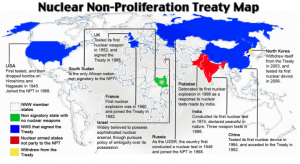Nonproliferation Treaty
Nearly fifty years ago, the Nonproliferation Treaty (NPT) gained significance. This treaty has actively promoted three goals: preventing non-nuclear states from acquiring nuclear weapons, promoting nuclear weapon states to disarm, and working on getting non-nuclear states peaceful nuclear technology. Today, the International Atomic Energy Agency (IAEA) holds the responsibility of ensuring countries do not develop nuclear weapons and works to engage in peaceful nuclear programs with such countries. Through the NPT, the IAEA “gained authority for policing the nuclear activities of member countries to ensure that those without nuclear weapons did not acquire them” (Bunn). However, the IAEA has failed to properly demand inspections of nuclear sites and countries, like Iran, Iraq, and North Korea, which have developed weapons in locations that are not open to inspection by the IAEA. Even more so, it has failed in effectively stopping countries from developing nuclear weapons (Bunn). Most importantly, the United States has failed to follow the original guidelines of the NPT as they continue to develop nuclear weapons of their own. During the Bush administration, the United States discouraged other countries from using and developing nuclear weapons, yet continued to develop and test weapons of their own (Bunn). Therefore, the IAEA has proven to be an ineffective authoritative body. For these reasons, the U.N and major global superpowers must use their collective authority to administer the original guidelines of the NPT better.

The NPT is effective in outlining the major goals and issues with nuclear weapon developments. The NPT recognizes that nuclear weapons are a threat and that nuclear proliferation will dismantle every region’s security across the globe. However, it lacks an effective way of enforcing it. Therefore, states like China, the United States, the United Kingdom, and Russia must use their authority over smaller states to prevent them from developing nuclear weapons by implementing sanctions. However, these powerful nations must first agree to a treaty that holds them accountable for following the guidelines of the NPT. Should these states not do so, the other treaty members will implement sanctions on the countries that go against the NPT. These states must lead by example, as smaller nations will follow. It is also crucial that these states hold their allies responsible by threatening to cut ties if they do not follow the NPT. As these smaller states feel safer with nuclear weapons out of the picture, they will no longer feel the need to develop these weapons themselves. Even more so, these smaller nations cannot afford such sanctions the way the United States, China, the United Kingdom, or Russia can. Therefore, their fear of a crippling economy will encourage them to oblige. The sanctions imposed on any state will continue until the state has shown clear evidence of stopping all developments and their active role in disarming current weapons. The treaty will force all members to meet once a year and provide evidence of such. Should a state fail to provide sufficient evidence each year, they will also receive sanctions until they do. If all fails, the treaty members must use military action until the state realigns with the conditions.
Responsibility to Protect Doctrine
Along with focusing on the NPT, we believe recent history has shown the Responsibility to Protect (R2P) doctrine’s weaknesses and feel it is important to strengthen it for current and future crises. The R2P doctrine was endorsed in 2005 unanimously by members of the United Nations (Paris 569). This doctrine outlined that when state leaders fail to protect their civilians, the international community needs to step in and “’should peaceful means be inadequate and national authorities manifestly fail to protect their populations from genocide, war crimes, ethnic cleansing and crimes against humanity’” (Paris 569). The first justification for coercive intervention under the R2P doctrine was Libya in 2011. Scholar Roland Paris argues that the “’operation and its aftermath exposed deep tensions in the strategic logic of preventive humanitarian intervention, and thus the heart of R2P’” and that there are five distinct structural problems of preventative humanitarian intervention (Paris 570). The five structural problems are the mixed motives problem, the counterfactual problem, the conspicuous harm problem, the end-state problem, and the inconsistency problem.

We believe the most problematic structural problem is the inconsistency problem, and therefore one of our policy suggestions is to work to fix this issue. Since there is no international police and our world exists in anarchy, under whose authority is it to organize and distribute responsibility to state actors when the R2P is needed? Given the nature of the doctrine, the R2P gives state actors the ability to act when civilians are in danger leaving room for states to pick and choose the situations in which they intervene (Paris 578). This is an issue because it creates the appearance of ‘double standards’ and “can only weaken the doctrine’s credibility” (Paris 578). Therefore, given what we have learned about making a threat and needing to be consistent with actions to make that threat credible, the United Nations needs to outline policy to address this inconsistency problem to help the doctrine’s credibility. We suggest this policy should create a special R2P task force within the United Nations to address all situations in which the R2P is applicable and intervene militarily in every situation in which it is permissible. This will create a domino effect in that as more state and non-state actors see how powerful this force is and are consistent in intervening militarily when the R2P is applicable, actors may be deterred from acting in fear of international military involvement. If all states in the UN stick together and all make a group effort to put money and resources into every problem that calls for military action, actors will see that the R2P doctrine is symbolic and action will meet any humanitarian crimes.
